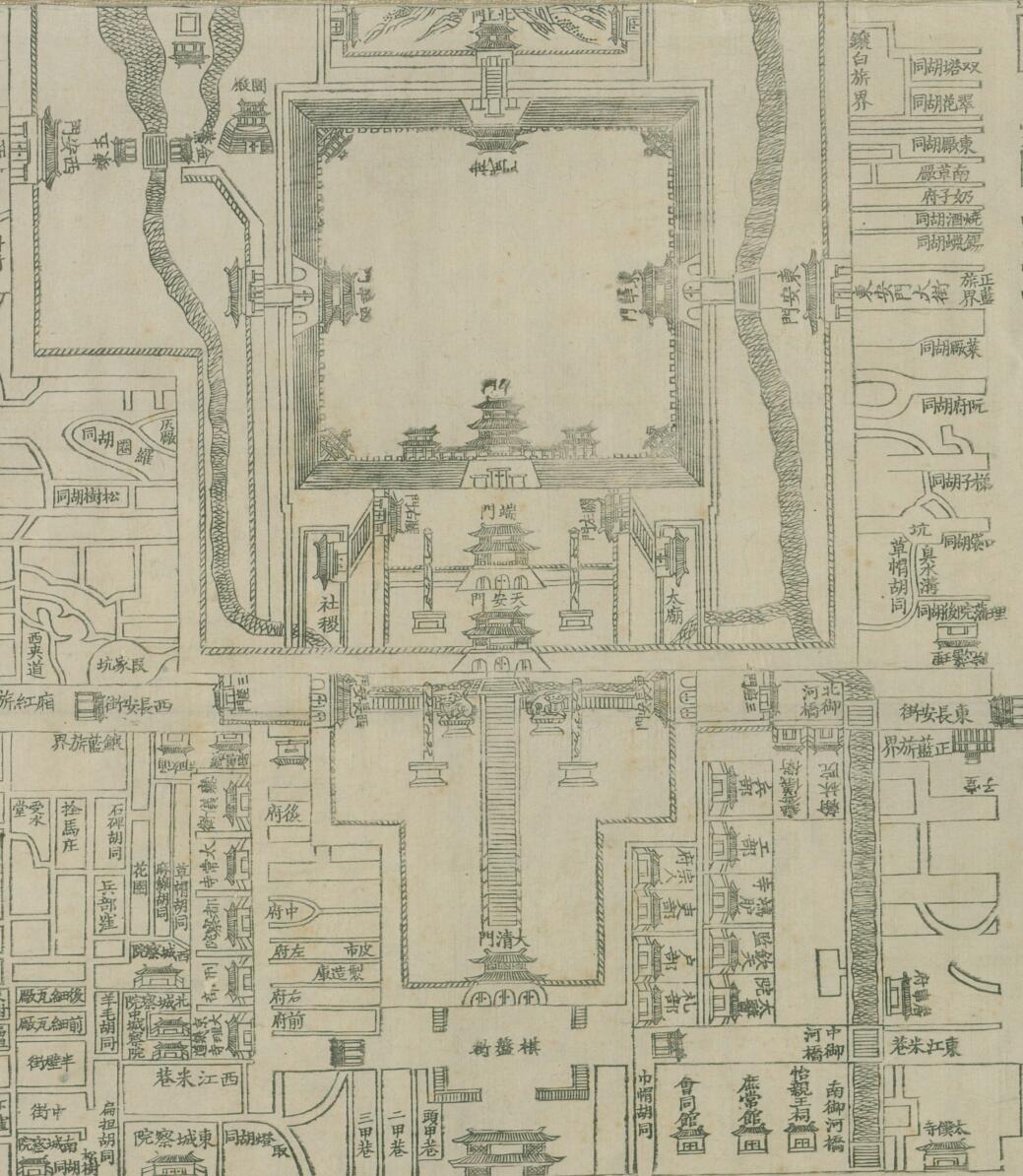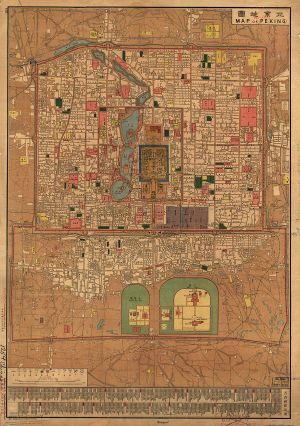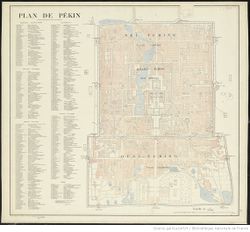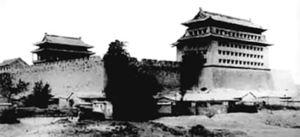A century in Beijing: Difference between revisions
No edit summary |
|||
| Line 109: | Line 109: | ||
|} | |} | ||
== Historical introduction to the map == | |||
This is a Map of Beijing. Printed by Chung Tung Litho Work (Zhong Dong Shi Yin Ju), Tianjin, in 1914. Scale 1:15,850. | This is a Map of Beijing. Printed by Chung Tung Litho Work (Zhong Dong Shi Yin Ju), Tianjin, in 1914. Scale 1:15,850. | ||
| Line 118: | Line 118: | ||
[[File:traditianal Chinese old map.jpg]] | [[File:traditianal Chinese old map.jpg]] | ||
At the end of the Qing Dynasty and the beginning of the Republic of China, the trend of Western learning was becoming more and more popular, and the mapping of maps was mostly based on Western methods. This map is a good example. Compared with the traditional Chinese map, which is accustomed to flatten the shape of the building, miniaturization (more emphasis on the style of the building and the approximate relative positional relationship, while the scale is not very important). This map uses uniform geometry, symbols and colors to represent similar things. At the same time, the figure uses a scale of 1:15 850 to further increase its accuracy. | At the end of the Qing Dynasty and the beginning of the Republic of China, the trend of Western learning was becoming more and more popular, and the mapping of maps was mostly based on Western methods. This map is a good example. Compared with the traditional Chinese map, which is accustomed to flatten the shape of the building, miniaturization (more emphasis on the style of the building and the approximate relative positional relationship, while the scale is not very important). This map uses uniform geometry, symbols and colors to represent similar things. At the same time, the figure uses a scale of 1:15 850 to further increase its accuracy. | ||
== Sections to be developed == | == Sections to be developed == | ||
* Outcome | * Outcome | ||
Revision as of 23:05, 16 December 2018
Using this map by France's Service Géographique de l'Armée from 1900 we will follow the evolution of the urban landscape of the central part of China's capital at several milestones through the decline of Qing dynasty, the birth of a republic, the establishment communism to the modern times. The city grew vey quickly over the last hundred years and is now way past its old borders. While some things in the downtown remained pretty unchanged like the Tiananmen Imperial Palace, numerous old constructions were demolished in an effort to modernize the town.
Outline
Sources
Goals
- To align maps from different time periods and see how the landscape changed. The town's straightforward rectangular planning will allow us to make matches more easily.
- Incorporating the geodata for finding places.
- The map has a rich legend with toponymic information in French and the dated French system of transliteration of Mandarin. The plan is to extract and match these place names with their modern counterparts.
- Add the old pictures of significant buildings that are no longer there if it's possible to find them.
- To present the results as a web resource.
Tools
- Google Firebase – non-SQL web-based database
- QGIS – map alignment software
- Google Cloud OCR – text recognition tool
- HTML, JS etc. – basic standard web development instruments
Project plan
- Find a proper map that can be used to align and containing enough information.
- Align the old map with the mordern one.
- Compar these two maps and extract the area where building changed.
- Extract the coordinates of the old building.
- Creat a database to record the name, function of the old building and the name and function of the current one.
- Compar these two maps and extract the area where the function of building was changed.
- Extract the coordinates
- Creat a database to record the name, function of the old building and the address of the appartment currently.
- Crea a website which can display the difference of two maps in an interactive way.
- high light all the areas which were rebuilt or function have been changed in different colors.
- For the area which were rebuilt:When putting cursor on this area,pop up window to show the instruction of old buildings and the current one.
- For the buildings which function were changed:When putting cursor on this area,pop up window to show the function of these departments and hight light the area where the current dapartment is.
Milestones
| Timeframe | Task | Completion |
|---|---|---|
| Week 8 | ||
| 07-09.11 | Choosing tools for the map alignment | ✓ |
| Aligning the old map with the modern satellite map | ||
| Applying DH-segment to automatically extract street and buildings’ shapes | ||
| Using Google OCR to extract word description | ||
| Evaluating current results | ||
| Selection of more suitable old maps | ||
| Week 9 | ||
| 14-16.11 | Map alignment | ✓ |
| Preparation of the midterm presentation | ||
| Week 10 | ||
| 21-23.11 | Developing the database structure | |
| Extracting the building shapes from the old map | ||
| Planning for the development of a website with the map | ||
| Week 11 | ||
| 28-30.11 | Finishing all the extraction jobs | |
| Adding the data to the database | ||
| First version of the website | ||
| Week 12 | ||
| 05-07.11 | Adding interactive functions | |
| Finishing the website | ||
| Week 13 | ||
| 12-14.12 | Project report | |
Historical introduction to the map
This is a Map of Beijing. Printed by Chung Tung Litho Work (Zhong Dong Shi Yin Ju), Tianjin, in 1914. Scale 1:15,850.
In this year, the Republic of China has just been established for three years. The capital of China has returned to Beijing from Nanjing. Since the Republic of China was just established at this time, there have been no major changes and changes in the buildings in Beijing. However, many of the original buildings of the Qing Dynasty were requisitioned by the government as the new functional departments of the Republic of China. For example, the Congress of the Beiyang Government, the various government departments have appeared on the map, and the Presidential Palace has been stationed in the Forbidden City.
The whole picture focuses on the distribution of buildings and streets in the city. The government departments are shown in red on the map, the school on green, the temple on yellow, the water in light blue, and the embassies and diplomatic sites in purple. By distinguishing these important places from other places through the use of different colors, these geographical matters are more conspicuous. Other building streets are more abbreviated, and there is no function or name. Some of the place names in the map are in Chinese and English, but the proportion of place names with English translation is not high. And below the map, there is a list of offices in the capitals of the provinces.
 At the end of the Qing Dynasty and the beginning of the Republic of China, the trend of Western learning was becoming more and more popular, and the mapping of maps was mostly based on Western methods. This map is a good example. Compared with the traditional Chinese map, which is accustomed to flatten the shape of the building, miniaturization (more emphasis on the style of the building and the approximate relative positional relationship, while the scale is not very important). This map uses uniform geometry, symbols and colors to represent similar things. At the same time, the figure uses a scale of 1:15 850 to further increase its accuracy.
At the end of the Qing Dynasty and the beginning of the Republic of China, the trend of Western learning was becoming more and more popular, and the mapping of maps was mostly based on Western methods. This map is a good example. Compared with the traditional Chinese map, which is accustomed to flatten the shape of the building, miniaturization (more emphasis on the style of the building and the approximate relative positional relationship, while the scale is not very important). This map uses uniform geometry, symbols and colors to represent similar things. At the same time, the figure uses a scale of 1:15 850 to further increase its accuracy.
Sections to be developed
- Outcome
- Code



